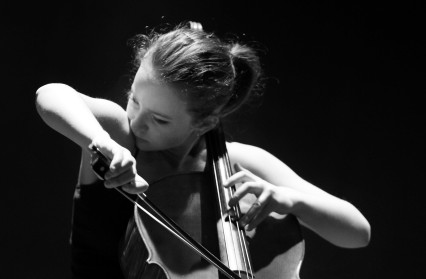Dora Stoutzker Hall, Royal Welsh College of Music & Drama, Cardiff
March 26, 2015
Beethoven: Symphony No. 8
Copland: Quiet City
Shostakovich: Cello Concerto No. 1
Sibelius: Pelléas et Mélisande
Cello: Laura van der Heijden
Conductor: Gareth Jones
Anyone tempted to describe the National Youth Jazz Orchestra as ‘a training band’ was likely to receive courteous short shrift from its founder and musical director, Bill Ashton. Much the same response, mutatis mutandis, would be expected from Gareth Jones in relation to Sinfonia Cymru, the orchestra of young professionals he established in the 1990s and still conducts. Both are more than a collection of apprentices. They are learning, of course, but they have to learn fast.
Jones, who set up the orchestra as a means of giving newly-graduated musicians a first entrée into the paid ranks, is on record as saying he would never be prepared to dip below a certain high standard of public performance, which is exactly what membership of any professional orchestra entails. Not so much a baptism of fire for his recruits, then, as repeated entry into a kitchen of unremitting industry and heat.
For him as for Ashton, chaperoning an ensemble whose members would be ever seeking more illustrious positions elsewhere was always going to be a challenge as much administrative and logistical as musical. Both have had to maintain maximum continuity while allowing for the possibility of someone whizzing off to some other career destination. For Jones, one way of keeping ranks closed has been to rely on the willingness of departed members to return, when their diaries permit, for the orchestra’s regular short tours of Wales, the latest of which – the first this year – opened in Cardiff before stops on successive days at Pontyberem Memorial Hall, the Newport Riverfront, and Clwyd Theatr Cymru in Mold. But it involves far more than that and in other places: last year was its busiest so far, with 44 concerts presented to audiences totalling more than 13,000. Sinfonia Cymru is the first and only orchestra of its sort to be revenue-funded by the Arts Council of Wales.
The de-constructed forest that is the Dora Stoutzker Hall tends to seduce the eye so that the ear interprets its acoustic as polished-wood perfect when it’s really, well, interesting. From where I was sitting on the rear balcony the drumbeats of the orchestra’s confident timpanist, Christina Slominska, in Beethoven’s Symphony No. 8 sounded like cannon shots, all very well when supporting a large orchestra but appearing to seek attention when lording it over a chamber group – which is what Sinfonia Cymru is – in their conventional, elevated place but without period kit. It was nothing to do with the musician, who was at all times present and correct.
That these issues have to be treated with respect and musical common sense was evident in Jones’s decision to place trumpet soloist Jason Lewis upstage right and cor anglais player Henry Clay downstage left to get the balance correct in Copland’s Quiet City. In most performances I’ve seen, the cor anglais is played by the musician seated at the customary desk. And was it my shortcomings or did guest cello soloist Laura van der Heijden, despite being lodged tightly and, again, conventionally ‘twixt conductor and leader Bartosz Woroch in Shostakovich’s Cello Concerto No 1, sound somewhat less than forward of the main sonic thrust?
It couldn’t have been ascribed to a lack of willingness by the prize-winning teenager to engage with Shostakovich’s febrile intensity, which she and Jones refused to mitigate, though hers is not a broad-shouldered cello sound and the sometimes sheer self-lacerating spirit of the score seemed a mite beyond its reach. But as a performance of focus and co-operative intent it said everything that needs to be said about this orchestra. It is to Jones’s credit that, despite the unavoidable coming and going, he has not stinted in pushing his young charges to the highest possible achievement in the widest possible repertory with the maximum concern for variety of programme-building.
Sibelius’s 150th anniversary was marked with an exquisite performance of the suite from Pelléas et Mélisande, music that tugs Maeterlinck’s drama away from its other-worldliness, not that the ice-and-fire domain of the composer could have accommodated any other. With barely thirty on the platform, the orchestra showed how unfazed it was when members were constantly found by the musical follow-spot, Clay’s cor anglais delineating Mélisande’s soulful features and the hyper-realism of Boroch’s inspired leadership in the Entr’acte being the first two of several examples, notably that of Carys Evans’s horn-playing, which was formally recognised by the conductor.
Clay’s geographical placing in Quiet City took a little bit away from the trumpet’s superior status, but Copland’s cool, nocturnal palette, depicting not the slightly anxious mood of an Edward Hopper scene but that of a largely untroubled, perambulating nighthawk, was rigorously applied. In such circumstances, the Beethoven symphony’s buoyancy at the end of the evening sounded particularly unimpeded and off-leash. It needs to be heard with, say, the Third and the Fifth on the same bill; but Gareth Jones, in his current repertorial quests, probably isn’t ready for that sort of conjunction just yet. Pity. His band would be up to it and up for it.
Photograph of Lauren van der Heijden by Sean Aidan.



 Enjoyed this article? Support our writers directly by buying them a coffee and clicking this link.
Enjoyed this article? Support our writers directly by buying them a coffee and clicking this link.







